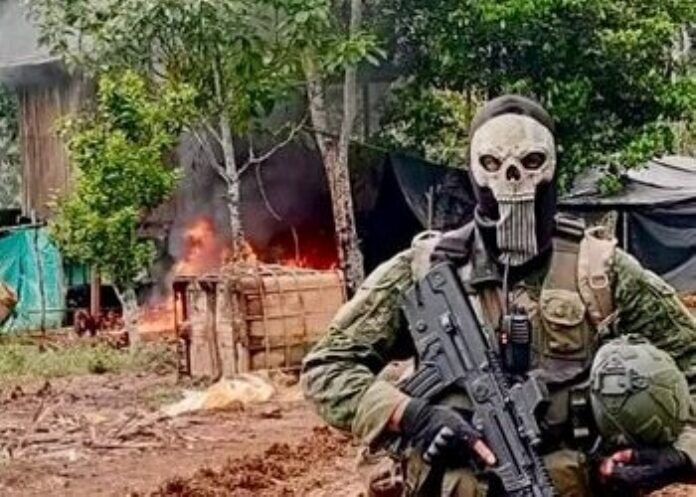Ecuador has deployed 1,800 soldiers to the country’s Amazon region
Massive operations by Ecuador’s military against illegal mining following a historic massacre will do little to slow one of the country’s most lucrative criminal economies.
The army announced in a May in social media post. In the operations unfolding since, security forces have seized heavy machinery, fuel, firearms, and other material used for illegal mining activities, other posts on the army’s social media show.
These military operations come as a direct response to one of the bloodiest attacks on Ecuador’s security forces in recent history. On May 9, gunmen ambushed a group of Ecuadorian soldiers during an anti-mining operation in the Amazonian province of Orellana, killing 11.
In a statement following the attack, Ecuador’s military attributed the murders to members of the Border Command (Comandos de la Frontera – CDF), a Colombian criminal group with a strong presence in Ecuador’s Amazon region near its border with Colombia.
“We will not rest until those responsible are brought to justice before the law,” the army added.
The CDF denied involvement in the attack, according to local media sources, blaming the event on Ecuadorian criminal groups. Ecuadorian authorities, however, identified one of the assailants killed in the clash as alias “Compadre,” the group’s presumed commander in Ecuador. Two other CDF members were also reportedly killed.
SEE ALSO: As Government Pressure Mounts, Ecuador’s Gangs Strike Gold
Consisting of a mix of former members of both paramilitary groups and the now-demobilized Revolutionary Armed Forces of Colombia (Fuerzas Armadas Revolucionarias de Colombia — FARC), the CDF has leveraged strongholds in the Colombian departments of Putumayo, Caquetá, and Amazonas to build a successful drug trafficking enterprise.
By regulating expansive coca cultivation in these provinces, the CDF manages cocaine transport routes across the border into Ecuador. From there, the drug is then exported to consumer markets, primarily in Europe and North America.
Recently, the CDF has become increasingly involved in illegal mining, especially in the Ecuadorian border provinces of Sucumbíos and Orellana. This is part of a wider trend in Ecuador and the region as criminal groups look to cash in on skyrocketing global gold prices.
The attacks on military members come as Ecuador is experiencing an unprecedented security crisis. Murders are 32% above record levels in the first four months of 2025, as criminal groups like the Lobos, Choneros, and Tiguerones fight for territory in an increasingly fragmented landscape. In response, Ecuador President Daniel Noboa has pushed a hard-line response, declaring over 20 Ecuadorian criminal groups military targets.
A week after the massacre, on May 15, Noboa designated the Border Command and other Colombian criminal groups like the Oliver Sinisterra Front — another FARC dissident group and the Comuneros del Sur, a now-independent faction of the National Liberation Army (Ejército de Liberación Nacional – ELN), “armed organized groups.” The measure will “reinforce security actions” against the groups.
InSight Crime Analysis
While the high-profile massacre has made combating mining groups a top concern for Ecuador’s military, the government has yet to address the economic drivers of illegal mining, as well as the endemic corruption that reinforces it.
Noboa’s response to the security crisis in Ecuador’s urban areas has been disorganized, lacking measures that address residents’ security concerns in other ways besides state force. The government’s approach to the compounding mining issue has been no different.
“The use of the military [against mining] does nothing but generate a smokescreen of a governmental reaction that has very little capacity to become effective,” Luis Córdova Alarcón, an Ecuadorian academic and security expert, told InSight Crime.
Facing pressure to present a security plan, Noboa introduced a sweeping new security bill to the legislature on May 17 that is “aimed at dismantling criminal economies” and “protecting citizens.” The proposal, which is still being debated, declares property belonging to organized criminal groups — including those involved in illegal mining — as “military objectives,” while promising additional measures to protect security forces from prosecution. But this will do little to combat illegal mining’s root causes.
“Even if they take away one backhoe or 100 backhoes, they are not solving the economic problem,” Cordova said. “There is a high market price that makes it easier to invest in that criminal economy.” Instead, he added, the government should invest in job creation and rural development measures that dissuade people from seeking work in illegal mining operations.
SEE ALSO: Organized Crime Cashes In on Record Gold Prices
High gold prices, however, will make the criminal economy difficult to resist. Journalistic investigations have found illegal mining to be worth hundreds of millions of dollars per year in Ecuador. Flush with cash, criminal groups funnel more resources into corruption networks, targeting actors within the security forces, the mining control agency (Agencia de Regulación y Control Minero – ARCOM), judges, local government officials, and private companies. Corruption may have even played a major role in the soldiers’ massacre, with an army spokesperson blaming the ambush on an internal leak that exposed the patrol’s location.
As more revenue is generated from illegal mining, more money will be funneled into corrupt networks that guarantee impunity. This creates a situation where corruption reinforces illegal mining and vice-versa.
“There is a vicious circle around illegal mining that makes it very difficult to eradicate,” Renato Rivera-Rhon, director of the Ecuadorian Organized Crime Observatory
More: InsightCrime.Org
By Gavin Voss



